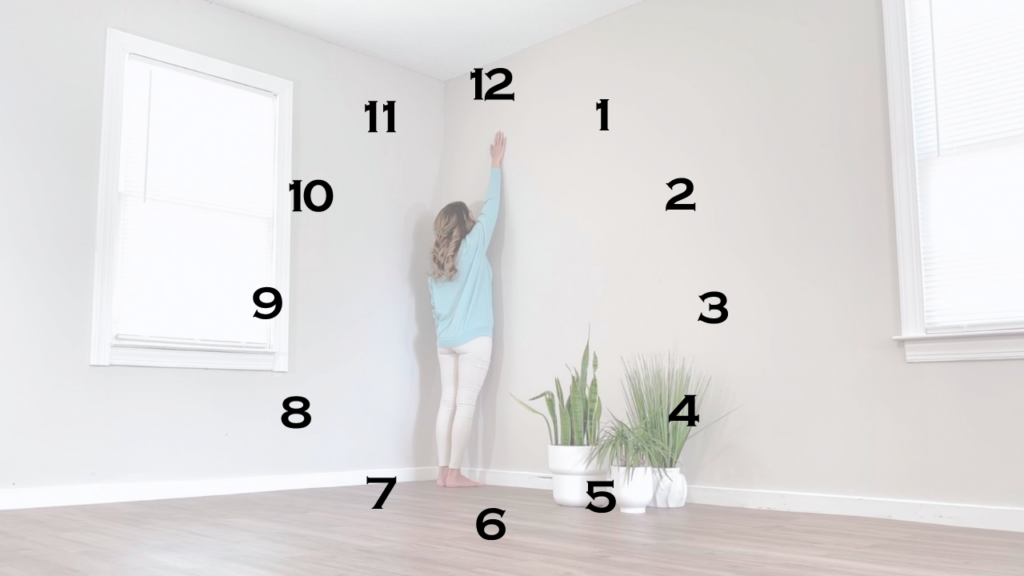
Do you have a wall clock? Great! Grab it off of your wall and let’s stretch!
Just kidding 😉 We actually get to BE the “wall clock” for this exercise (don’t worry, it’s a stretch, but I’ll use the two words interchangeably).
Wall clocks are an excellent way to stretch the entire front side of the upper body. This is one of my faves when working with clients/patients, and it’s also one I personally enjoy doing while watching tv (well, mostly listening to the TV). This stretch is great for those who suffer from chronic headaches and migraines, and anyone who sits at a desk, in a car, or has a cell phone (tech neck anyone?). For most of us, our neck muscles get tight in positions not intended, thanks to modern life: watching tv, working on a computer, texting on our phones, and driving our cars. Then the muscles in our chest and sides have to compensate for the new neck posture. Eventually, this leads to chronic tightness and pain, and not always in the areas you expect.
Depending on your overall mobility and your daily activities, wall clock typically stretches the latissimus dorsi, anterior deltoid, medial deltoid, biceps, pectoralis minor, pectoralis major, upper trapezius, and the scalenes. Whoa, that’s a lot of muscles! But that’s why I said it’s “The best way to stretch your upper body.” (yes, I am fully aware it does not get the back side of your upper body, but that would have been a really long title).
To start this stretch stand facing a wall… get really close to it, think nose to the wall. The “12” on the clock is directly above your head, the “6” is in line with your legs, your right arm straight out from your shoulder would be “3”, and your left arm straight out would be “9”.

Before we move on, this stretch can be modified to adapt to nearly any situation. You don’t have to move through the whole “clock” to benefit, and you don’t have to go in the order below. Only do the “numbers” you feel comfortable doing if you have a shoulder injury or frozen shoulder. And as always, make sure you are cleared by your doctor or physical therapist before doing any form of physical activity. Hold each position on the clock for a few breaths. I personally like to hold each one for 5 slow breaths. If you’re a kinesthetic (like myself) or auditory learner, feel free to follow along with the video below instead of reading the [rest of the] instructions.
Start facing the wall with your nose nearly touching the wall. Lift the right arm straight up to the “12” o’clock position. If you feel a stretch here you can stay here for a few breaths trying to relax the side (lats) of your body.
Move the right arm to the “1” o’clock position. The right arm should make as much contact with the wall as possible, but it doesn’t need to be firmly pressed. Keeping the contact of the arm with the wall, turn your body to the left (away from your right arm) until you feel sensation. As you turn, the shoulder should get closer to the wall and might make contact with the wall. Breathe here trying to soften, relax, and release. After a few breaths (again I recommend 5) return the body back to the wall.
Move the arm down to the “2” o’clock position. Again keeping contact of the arm with the wall, turn the body away from the right arm noticing sensation. The right shoulder may or may not make contact with the wall. Notice how this position might feel different from the “1” o’clock position. After a few breaths return the body back to the wall.
For 3 o’clock, the arm goes straight out from the shoulder so it is parallel to the floor. The arm can be straight or the elbow can be bent at 90 degrees. You can pick and choose, or you can do both of these options and hang out at the 3 o’clock position for a while. If you choose to do both, return the body to facing the wall before you switch positions. The directions are the same as above, remembering to move to sensation, noticing where you feel the stretch, and always continuing to breathe slowly and deeply. With the arm straight many people feel more of a stretch in their shoulder (anterior deltoid), with the elbow bent the stretch often moves more towards the pecs (pectoralis major and minor).
The directions are the same as 2 o’clock. More than likely the shoulder will make contact with the wall. When it does make contact, make sure it’s the front side of the shoulder (anterior deltoid) that is making contact and not the side of the shoulder (medial deltoid).

You can skip the “6”. We lay, sit, and stand in this position all day.
WAIT! 12!? Yes, we’re going to mirror what we just did, but on the left side. Just like we did on the right side for “12” start facing the wall but this time lift the left arm straight up. Again, if you’re not feeling any stretching here feel free to move on to 11 o’clock.
Move the left arm down the wall to 11 o’clock. Keep contact between the left arm and the wall and slowly turn the body toward the right away from the left arm. Move into sensation. Pause. And breathe. Notice where you’re feeling the stretch, and without judging or labeling notice how this side may feel different than the right side.
Again these are mirror images of the stretch we did on the right side. Remember to move into sensation, breathe, and notice how the stretch changes as you move from one number to the next, and how it may feel different on this side versus the right side.
It only takes 5 min to move through the WHOLE clock, a small about of time to counter all the sitting at our desks, in our cars, or on our couches. Wall clocks are my favorite way to stretch out the entire upper body, but flexibility is only one piece of the puzzle. For optimum mobility, excellent posture, and pain-free living strength is an essential piece.
“The Marlysa” is my favorite back exercise because it focuses on muscles everyone overlooks. Check out this blog post or watch the video for more, but before you move on, do wall clocks (or Door Cactus) for the best results.
All of these exercises and stretches can be used together to help improve posture, minimize upper body tension, and reduce tension headaches.
Sign up for my newsletter below to learn more ways to increase your mobility, decrease your pain, and how to use your wall clocks and other household items in your daily yoga practice.
Kidding. 😆
But not really. 🤔
Sign up for my newsletter to stay informed. Get the latest news on the latest yoga trainings, tutorials, blog posts, and discounts.